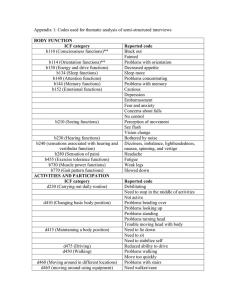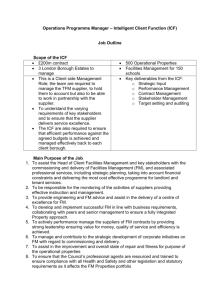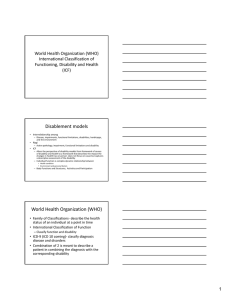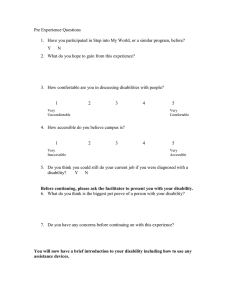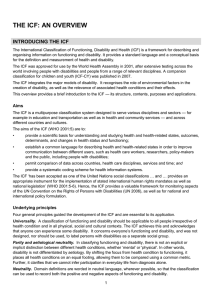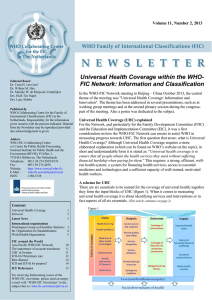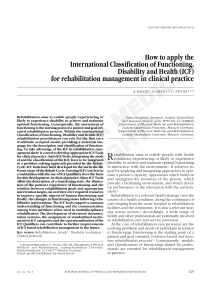Practice Matters: What is the ICF?
advertisement
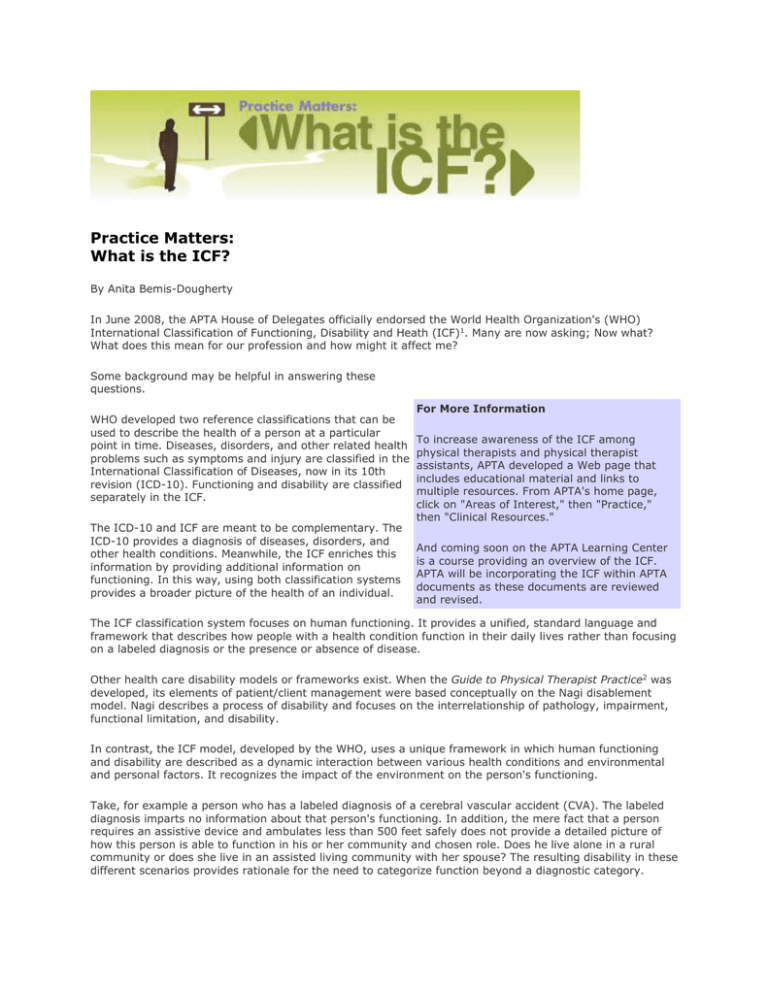
Practice Matters: What is the ICF? By Anita Bemis-Dougherty In June 2008, the APTA House of Delegates officially endorsed the World Health Organization's (WHO) International Classification of Functioning, Disability and Heath (ICF)1. Many are now asking; Now what? What does this mean for our profession and how might it affect me? Some background may be helpful in answering these questions. WHO developed two reference classifications that can be used to describe the health of a person at a particular point in time. Diseases, disorders, and other related health problems such as symptoms and injury are classified in the International Classification of Diseases, now in its 10th revision (ICD-10). Functioning and disability are classified separately in the ICF. The ICD-10 and ICF are meant to be complementary. The ICD-10 provides a diagnosis of diseases, disorders, and other health conditions. Meanwhile, the ICF enriches this information by providing additional information on functioning. In this way, using both classification systems provides a broader picture of the health of an individual. For More Information To increase awareness of the ICF among physical therapists and physical therapist assistants, APTA developed a Web page that includes educational material and links to multiple resources. From APTA's home page, click on "Areas of Interest," then "Practice," then "Clinical Resources." And coming soon on the APTA Learning Center is a course providing an overview of the ICF. APTA will be incorporating the ICF within APTA documents as these documents are reviewed and revised. The ICF classification system focuses on human functioning. It provides a unified, standard language and framework that describes how people with a health condition function in their daily lives rather than focusing on a labeled diagnosis or the presence or absence of disease. Other health care disability models or frameworks exist. When the Guide to Physical Therapist Practice2 was developed, its elements of patient/client management were based conceptually on the Nagi disablement model. Nagi describes a process of disability and focuses on the interrelationship of pathology, impairment, functional limitation, and disability. In contrast, the ICF model, developed by the WHO, uses a unique framework in which human functioning and disability are described as a dynamic interaction between various health conditions and environmental and personal factors. It recognizes the impact of the environment on the person's functioning. Take, for example a person who has a labeled diagnosis of a cerebral vascular accident (CVA). The labeled diagnosis imparts no information about that person's functioning. In addition, the mere fact that a person requires an assistive device and ambulates less than 500 feet safely does not provide a detailed picture of how this person is able to function in his or her community and chosen role. Does he live alone in a rural community or does she live in an assisted living community with her spouse? The resulting disability in these different scenarios provides rationale for the need to categorize function beyond a diagnostic category. In the ICF framework, the emphasis moves away from the notion of an individual as being handicapped by his/her diagnosis. Disability and functioning are generic terms describing the broad concepts of an individual's function or inability to function. "Body Functions and Structures" and "Activities and Participation" replace previously used terms of "impairment," "disability," and "handicap." The new terms allow positive experiences to be described. Disability is used to indicate problems in body function and structures, activity limitations, and participation restrictions. Non-problematic or neutral aspects of health are summarized under the term "Functioning." By using this system, one can describe any changes that occur in the body, the whole person, the person's ability to perform tasks, his or her social roles, and the environment that forms the context of a person's life. ICF provides a language of function and health that can be understood by those who interact with each other on health-related issues, and helps to bridge gaps between the patient/client, provider, policy maker and payers. The ICF framework and its standardized language better describes the work of rehabilitation and can be a means to facilitate the communication across the health care community, stimulate interdisciplinary research, and enhance the role of the rehabilitation professional with patients and other health care providers, with the ultimate goal of improving clinical care. In clinical practice, the ICF offers a large area of domains that may be considered when evaluating a patient and in determining what other influences may be affecting the patient, such as environmental factors. Once these areas are considered, the PT has the opportunity to target interventions and involve others who may be able to provide care for the patient from a different perspective (such as psychology, occupational therapy, speech-language pathology, etc) so that all of the patient's needs are met. ______________ Anita Bemis-Dougherty, PT, DPT, MAS, is associate director of APTA's Department of Practice. References: 1. International Classification of Functioning, Disability and Health, World Health Organization, 2001, Geneva. 2. Guide to Physical Therapist Practice, 2nd Ed. Phys Ther. 2001; 81:9-744. 3. Nagi SZ. Some conceptual issues in disability and rehabilitation. In: Sussman MB, ed, Sociology and Rehabilitation. Washington, DC: American Sociological Association; 1965:100-113 PT Magazine - February 2009
